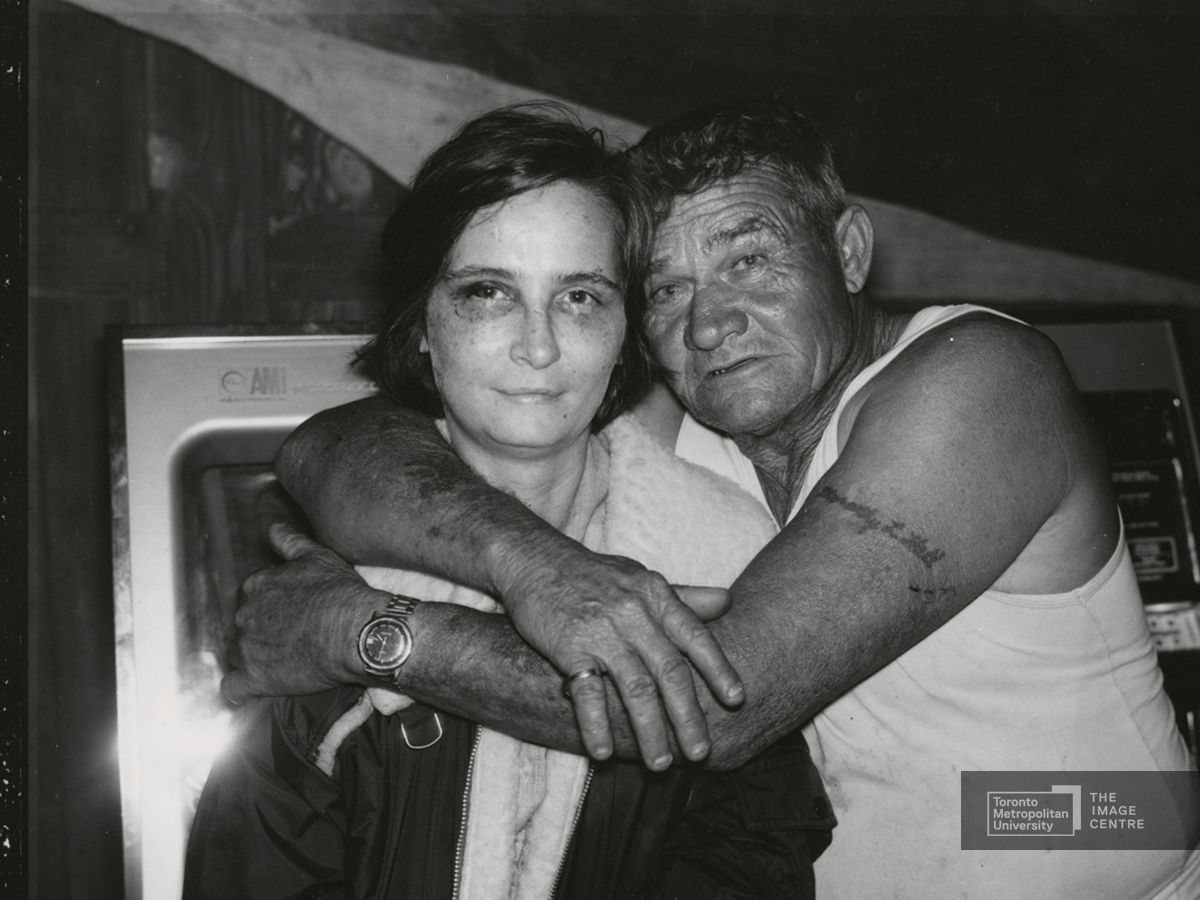Shrimper's Wife and Friend
Feminist Theories
Feminist Theories: the legal system and society as a whole do not see the victimization of women as a serious problem.
Title: Wife of Shrimper (not pictured) beaten for being found with another man (also not pictured). Shrimpers wife and friend.
Object Type: photograph
Dimensions: 11 x 14"; 27.94 x 35.56 cm
Medium: gelatin silver print
Date: n.d.
Location: unknown
Accession No: BS.2005.280140
Photographer: Bill Burke, American, b. 1943 d. unknown.
Category: The Black Star Collection, Toronto Metropolitan University. Courtesy of The Image Centre.
Inscriptions: Recto, [no inscription]; Verso, handwritten: Violence; stamped: Good Art; handwritten: 274; stamped: 02087; handwritten: Wife of shrimper (not pictured) beaten for being found / with another man. (also not pictured); stamped: Archive Pictures Inc. 111 Wooster St., New York, N.Y. 10012 [crossed out]; stamped: [star shape] Black Star; handwritten: not pictured / Shrimper came home from 3wk trip and found his wife (pictured) with some guy (not pictured) / Shrimpers wife and friend. Bayou Le Batre Alabama / Bill Burke; stamped: [copyright] Bill Burke.

Museum Label by Allessandra Sferrazza and Samantha Melsom, CR8002 : Critical Engagement and Criminological Theories, Winter 2020
Bill Burke is an American photographer born in Derby, Connecticut USA in 1943. Throughout the 1970s and 1980s Burke photographed his travels throughout Asia, specifically in Vietnam, Cambodia and Laos. He was specifically interested in using photography to document his personal reactions to people who have been impacted by events such as the Vietnam war. His photographs reflect the culture of the citizens who have been impacted by these events. Many Vietnamese immigrants came to Bayou La Batre after the Vietnam war as it has a similar shrimping industry to the one in Vietnam. This may be what brought Burke to Bayou La Batre. Bayou La Batre is a small town in Southern Alabama known for its local fishing and seafood industry. There is a low socioeconomic status for a majority of the residents, and the fishing and shrimping industry is central to the town’s economy.
The photograph is not dated. However, the object in the background is labelled as an “AMI Microprocessor” which has been used to date the photograph. AMI Microprocessors were not created until 1975. Additionally, the majority of Burke’s recognized works were photographed between the 1970s and 1990s. The Vietnam war ended in 1975, and if Burke was following Vietnamese immigrants post-war, this places the photograph sometime after 1975. Through this, it is assumed that the photograph was taken between the mid/late 1970s and early/mid 1980s.
This photograph is of a woman standing with two black eyes, which she received in a beating from her husband after he found her in bed with another man on his return from a three-week shrimping trip. While domestic abuse was not legally permitted at the time that the photograph was estimated to be taken, there was still great social acceptance of this practice and little enforcement of the laws prohibiting domestic abuse. Much of this was due to the perception of domestic issues being a private matter, and the subordinate role of women, especially during the 1970s and 1980s.
Bill Burke’s aim within his photography is to reflect the culture of the subjects in his photographs, conveying this to his audience. The culture these subjects are situated within is the social and institutional conventions of Southern Alabama in the late 1970s and early 1980s. This was a time of great social change within the United States with many groups within society, including the Women’s Movement and Civil Rights Movement, demanding social and political change to remove certain institutionalized power imbalances within society.
The culture of this society that the photograph is situated within may be different than at the time of the photograph. Yet, while you look at the photograph, reflect on where these embedded cultural ideals exemplified within the photograph have changed and exist within today’s society.
Bibliography
- Burke, B. (Artist). (n.d.). Wife of Shrimper [not pictured] beaten for being found with another man [also not pictured]. Shrimpers wife and friend. Bayou Le Batre Alabama. Bayou La Batre, Alabama. Black Star Library, Ryerson Image Centre.
- Belzer, Holzman, & Kent, (1978). Encyclopedia of computer science and technology: Volume 10. New York, USA: Marcel Dekker, Inc.
- International Center of Photography (n.d.) Bill Burke. Retrieved from The International Center of Photography (external link, opens in new window)
- Kaetz, J. (2012). Bayou La Batre. Retrieved from the Encyclopedia of Alabama (external link, opens in new window)
- Macchi, V. (n.d.) Half a world away, Vietnamese build lives on the American Bayou. Retrieved from VOANews (external link, opens in new window)
- PBS (n.d.) Bill Burke’s gallery. Retrieved from the Public Broadcasting Service (external link, opens in new window)